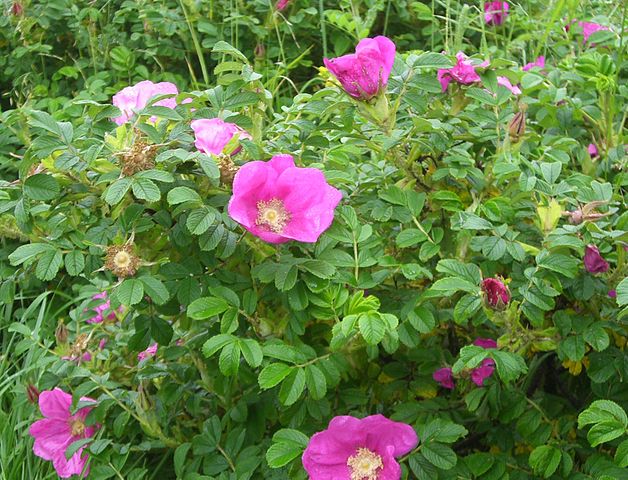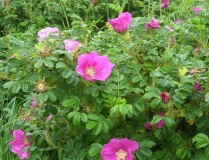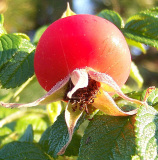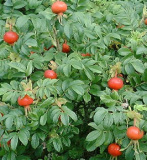- Home
- >
- Seeds of Shrubs and Climbers A-Z by Latin Name
- >
- Rugosa Rose, Japanese Rose, or Ramanas Rose (rosa rugosa)
Rugosa Rose, Japanese Rose, or Ramanas Rose (rosa rugosa)
SKU:
£1.10
1.1
85
£1.10 - £85.00
Unavailable
per item
Seed Prices
2 grams (approx 140 seeds) £1.10
5 grams (approx 350 seeds) £1.85
10 grams (approx 700 seeds) £2.75
25 grams (approx 1750 seeds) £6.50
50 grams (approx 3500 seeds) £12.00
100 grams (approx 7000 seeds) £20.00
250 grams (approx 17500 seeds) £45.00
500 grams (approx 35000 seeds) £85.00
Use the drop down button below to select the seed quantity
The Rugosa Rose is native to eastern Asia, in north-eastern China, Japan, Korea and south-eastern Siberia. It is widely used as an ornamental plant. It has been introduced to numerous areas of Europe and North America.
It is very thorny and fast growing to a maximum height of just over 2 metres (6-7') Easy to grow and usually trouble free it grows on almost any soil type except for waterlogged conditions. Best planted in full sun and can be cut back hard it it grows too unruly.
The mostly pink flowers appear from early summer until early autumn and are pleasantly scented and generally between 6–9 cm across. It usually starts to flower during the first growing season.
The hips are large, 2–3 cm diameter, and often shorter than their diameter, not elongated; in late summer and early autumn the plants often bear fruit and flowers at the same time. The leaves typically turn bright yellow before falling in autumn
This species hybridises readily with many other roses, and is valued by rose breeders for its considerable resistance to the diseases rose rust and rose black spot. It is also extremely tolerant of salt spray and storms and can be found even growing on the beach, just above the high tide mark. This extreme salt tolerance makes it a good shrub for planting along busy roads where a lot of salt spray is thrown up during the winter months. It is widely used in landscaping, being relatively tough and trouble-free and needs little maintenance.
The seed naturally has a deep dormancy which requires a degree of patience to overcome, full details on how to do this are sent with every order.
It is very thorny and fast growing to a maximum height of just over 2 metres (6-7') Easy to grow and usually trouble free it grows on almost any soil type except for waterlogged conditions. Best planted in full sun and can be cut back hard it it grows too unruly.
The mostly pink flowers appear from early summer until early autumn and are pleasantly scented and generally between 6–9 cm across. It usually starts to flower during the first growing season.
The hips are large, 2–3 cm diameter, and often shorter than their diameter, not elongated; in late summer and early autumn the plants often bear fruit and flowers at the same time. The leaves typically turn bright yellow before falling in autumn
This species hybridises readily with many other roses, and is valued by rose breeders for its considerable resistance to the diseases rose rust and rose black spot. It is also extremely tolerant of salt spray and storms and can be found even growing on the beach, just above the high tide mark. This extreme salt tolerance makes it a good shrub for planting along busy roads where a lot of salt spray is thrown up during the winter months. It is widely used in landscaping, being relatively tough and trouble-free and needs little maintenance.
The seed naturally has a deep dormancy which requires a degree of patience to overcome, full details on how to do this are sent with every order.
Germination, Sowing and After Care Information for
Rugosa Rose (rosa rugosa)
Seeds of the Rugosa Rose have a deep dormancy within them, this requires a degree of patience to overcome and it is usually quite easy to get high levels of germination if the correct methods are followed.
First prepare a free draining substrate into which the seeds are to be mixed, this can be a 50/50 mixture of compost and sharp sand, or perlite, vermiculite. The chosen substrate needs to be moist (but not wet), if you can squeeze water out of it with your hand it is too wet and your seeds may drown and die.
Mix the seeds into the substrate, making sure that their is enough volume of material to keep the seeds separated. Place the seed mixture into a clear plastic bag (freezer bags, especially zip-lock bags are very useful for this -provided a little gap is left in the seal for air exchange) If it is not a zip-lock type bag it needs to be loosely tied.
Write the date on the bag so that you know when the pre-treatment was started.
The seeds of this species require a cold period to break the dormancy that is within the seeds. This dormancy is their to prevent the seed from germinating during the autumn and winter when conditions outside would be unsuitable for growth. The breaking of this is easily achieved by placing the prepared bag of seeds in the fridge at (4 Celsius or 39F) for a period of between 12 and 16 weeks. During this time make sure that the pre-treatment medium does not dry out at any stage or it will be ineffective!
It is quite possible for the seeds to germinate in the bag at these temperatures when they are ready to do so, if they do, just remove them from the bag and carefully plant them up. When the period of pre treatment has finished the seed should be ready to be planted. Small quantities can be sown in pots or seed trays filled with a good quality compost and cover them with a thin layer of compost no more than 1 cm deep. For larger quantities it is easiest to sow the seeds in a well prepared seedbed outdoors once the pre-treatment has finished and wait for the seedlings to appear.
It has also been found that fluctuating pretreatment temperatures that mimic the natural cycle can give the best germination results and I have myself had excellent results by keeping the mixed seeds in a cold shed through the winter for the cold stage of their pre-treatment and allowing the temperature to fluctuate naturally. Ungerminated seeds can have the cold pre-treatment process repeated again to enable more seeds to germinate.
Do not expose newly sown seeds to high temperatures (above 25 Celsius). Keep the seedlings well watered and weed free.
Growth in the first year is usually between 15 and 30 cm depending on the time of germination and cultural techniques and developing seedlings are usually trouble free. Allow them to grow for 1 or 2 years before planting them in a permanent position.
First prepare a free draining substrate into which the seeds are to be mixed, this can be a 50/50 mixture of compost and sharp sand, or perlite, vermiculite. The chosen substrate needs to be moist (but not wet), if you can squeeze water out of it with your hand it is too wet and your seeds may drown and die.
Mix the seeds into the substrate, making sure that their is enough volume of material to keep the seeds separated. Place the seed mixture into a clear plastic bag (freezer bags, especially zip-lock bags are very useful for this -provided a little gap is left in the seal for air exchange) If it is not a zip-lock type bag it needs to be loosely tied.
Write the date on the bag so that you know when the pre-treatment was started.
The seeds of this species require a cold period to break the dormancy that is within the seeds. This dormancy is their to prevent the seed from germinating during the autumn and winter when conditions outside would be unsuitable for growth. The breaking of this is easily achieved by placing the prepared bag of seeds in the fridge at (4 Celsius or 39F) for a period of between 12 and 16 weeks. During this time make sure that the pre-treatment medium does not dry out at any stage or it will be ineffective!
It is quite possible for the seeds to germinate in the bag at these temperatures when they are ready to do so, if they do, just remove them from the bag and carefully plant them up. When the period of pre treatment has finished the seed should be ready to be planted. Small quantities can be sown in pots or seed trays filled with a good quality compost and cover them with a thin layer of compost no more than 1 cm deep. For larger quantities it is easiest to sow the seeds in a well prepared seedbed outdoors once the pre-treatment has finished and wait for the seedlings to appear.
It has also been found that fluctuating pretreatment temperatures that mimic the natural cycle can give the best germination results and I have myself had excellent results by keeping the mixed seeds in a cold shed through the winter for the cold stage of their pre-treatment and allowing the temperature to fluctuate naturally. Ungerminated seeds can have the cold pre-treatment process repeated again to enable more seeds to germinate.
Do not expose newly sown seeds to high temperatures (above 25 Celsius). Keep the seedlings well watered and weed free.
Growth in the first year is usually between 15 and 30 cm depending on the time of germination and cultural techniques and developing seedlings are usually trouble free. Allow them to grow for 1 or 2 years before planting them in a permanent position.







